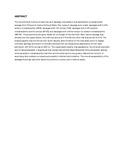Effect of tempe and sodium metabisulphite on the microbiological quality, development of rancidity, and sensory quality of Nile perch (Lates niloticus) sausages

Date
1999-06Author
Owino, Victor O
Muroki, N M
Type
ArticleLanguage
enMetadata
Show full item recordAbstract
The conventional method of beef and pork sausage manufacture was adopted for processing fish sausage from Nile perch (Lates niloticus) fillets. Four types of sausage were made: sausages with 0.02% sodium metabisulphite (MCS); sausages with 10% tempe (TCS); sausages with 0.02% sodium metabisulphite and 5% tempe (MTCS); and sausages with neither tempe nor sodium metabisulphite (SWTM). The proportions are given based on the weight of the fish fillet. Each type of sausage was divided into two equal halves. One half was stored at 5°C while the other half was stored at 20°C. The keeping quality was monitored over seven days by determination of the total plate count to assess microbial spoilage and extent of rancidity development as measured by absorbance of their light petroleum (40°-60°C) extract at 269 nm. The organoleptic quality was assessed by 18 untrained panelists and 3 trained panelists. It was found that tempe had antimicrobial effects but little antioxidant activity, whereas sodium metabisulphite had little antimicrobial activity but greatly reduced the content of secondary lipid oxidation products and possibly inhibited lipid oxidation. The overall acceptability of the sausages was high (scores of about five points on a seven-point hedonic scale).
URI
http://www.ingentaconnect.com/content/nsinf/fnb/1999/00000020/00000002/art00007http://erepository.uonbi.ac.ke:8080/xmlui/handle/123456789/54337
Citation
Food & Nutrition Bulletin, Volume 20, Number 2, June 1999 , pp. 221-227(7)Publisher
University of Nairobi Department of Food Science, Nutrition & Technology
